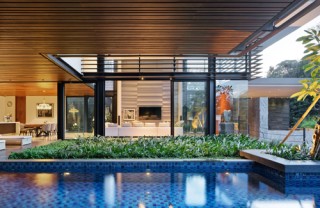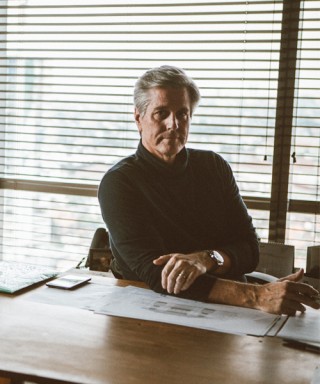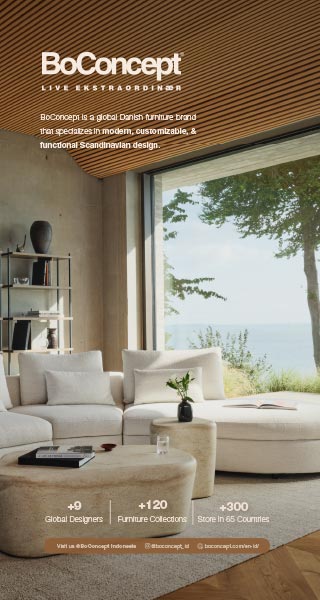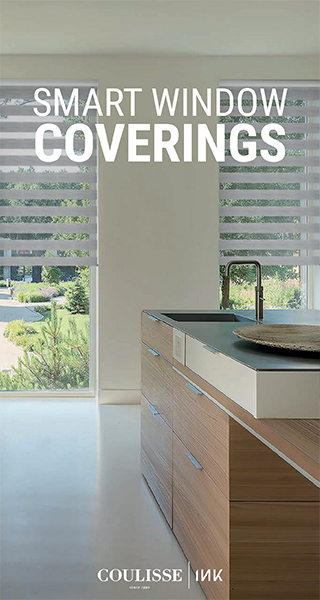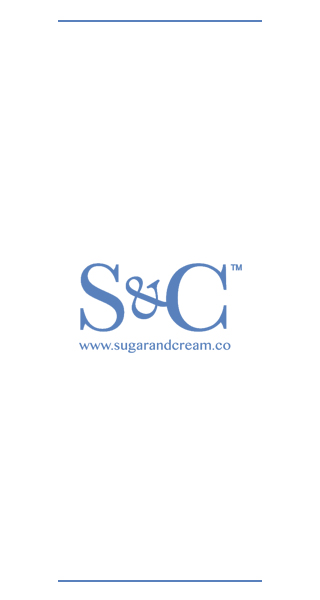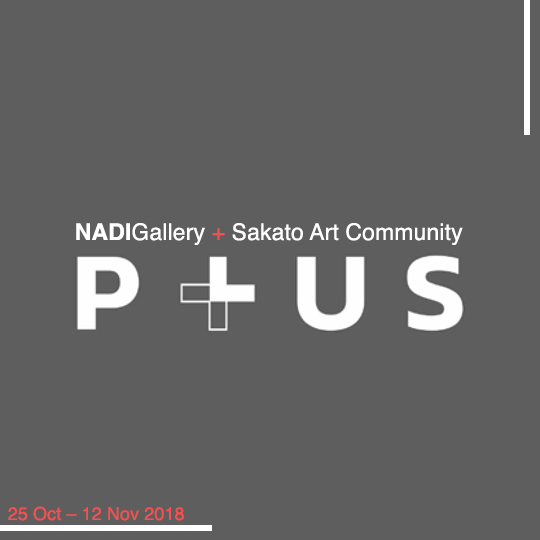
Nadi Gallery + Sakato Art Community : P+us
Published by Sugar & Cream, Monday 22 October 2018
Text and Images courtesy of Nadi Gallery & Anton R Makoginta
Nadi Gallery : 25 October 2018 – 12 November 2018
It is an honor for me to, once again, be able to organize a Sakato Art Community (SAC) exhibition, with a theme PLUS.
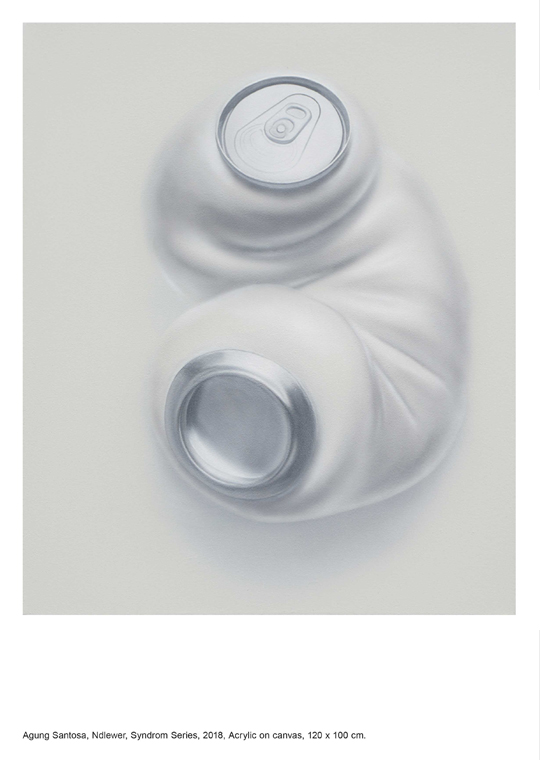
It was a friendship with fellow members of Jendela Fine Arts Community (Kelompok Seni Rupa Jendela – KSRJ)—Handiwirman Saputra, Jumaldi Alfi, M. Irfan, Rudi Mantofani, Yunizar, that brought me to get to know SAC in the first place.
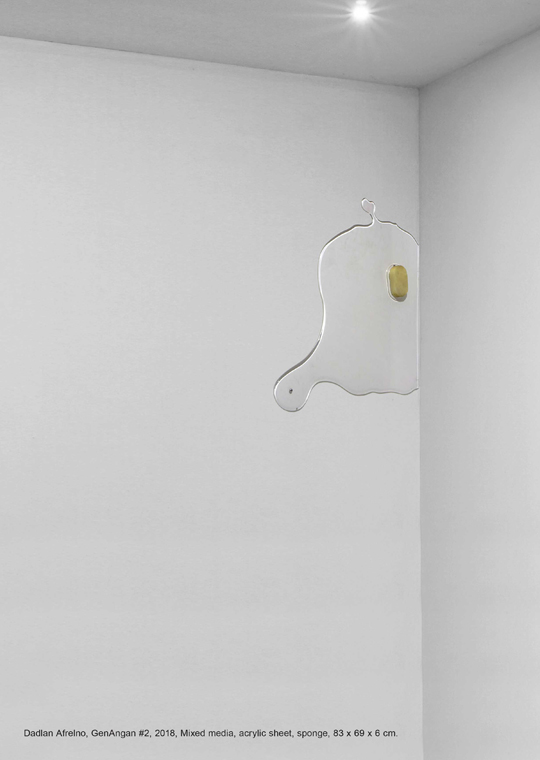
SAC is a fine arts community, of which the members commonly came from Padang – West Sumatera. Having been standing for more than twenty years, SAC is one of the fine arts communities that is still actively working for the society. This community is an example of how a fine arts education from a particular region is able to equip a significant number of artists to keep improving their creativity, without having to disregard the place where they grew up. Associating themselves with different forms of thoughts, patterns, style, and also different approach of contemporary fine arts in Yogyakarta, as well as broadening their sphere of social community, SAC surely provides artists with well-enough guide to keep advancing their creativity, without having to close their eyes to the roots of the place where they have grown.
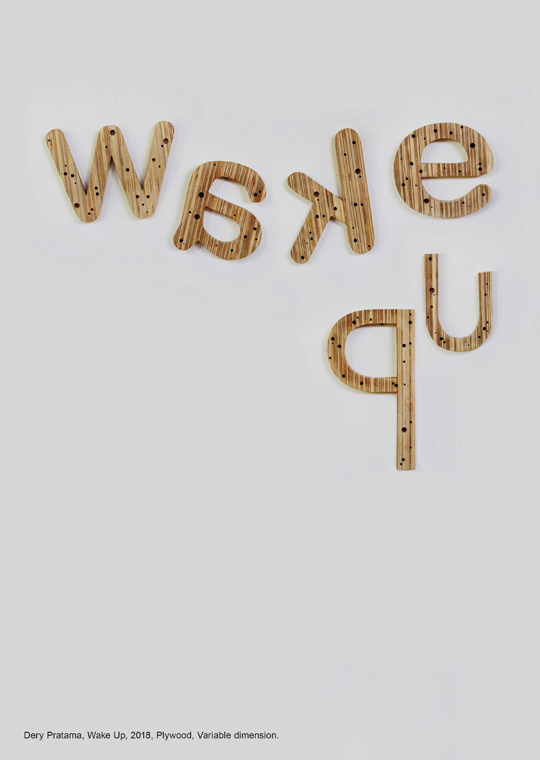
I convey my gratitude to my fellow partners at ‘Sakato Art Community’ who have successfully presented their proposal for this exhibition to the artists :
Agung Santosa, Dadlan Afrelno, Dery Pratama, Ega Budaya Putra, Erianto, Feri Eka Candra, Hojatul Islam, Ipan Lasuang, Jhoni Saputra, Melta Desyka, Oktaviyani, Rudi Hendriatno, Taufik Ermas, Trien ‘Iien’ Afriza, Yusra Martunus, Zulfirman Syah— and Erizal As, Faisal Azhari, Bayu Whardana, Anton Rais Makoginta, Handiwirman Saputra. I sincerely hope that this collaboration will continue further in the near future. I also wish to express my appreciation to Mr. Rudi Lazuardi who is willing to open this exhibition. This exhibition will be impossible without the help and cooperation of these fellow partners above. (Biantoro Santoso)
Curatorial Text by Anton R Makoginta
This exhibition is organized based on the awareness regarding the tendency of a certain number of artists in Sakato Art Community, in their process of materializing their artworks. As one of the attempts to discuss about different ways and processes in creating artworks, Von Hantelmann in his essay, The Rise of the Exhibition and Exhibition as Art in Aesthetics and Contemporary Art raised a question, “If artworks in an exhibition—regardless of their artistic purposes—are being used for serving the needs of dominant values in the present- day social formations, how would we be able to discuss about the meaning production autonomy and experience?” He also stressed that people, in frequent times, perceive and be aware of certain artworks necessarily as it is, without having to regard their artists or the audience. They, if truth be told, try to make a connection with the place where the artworks are being presented.
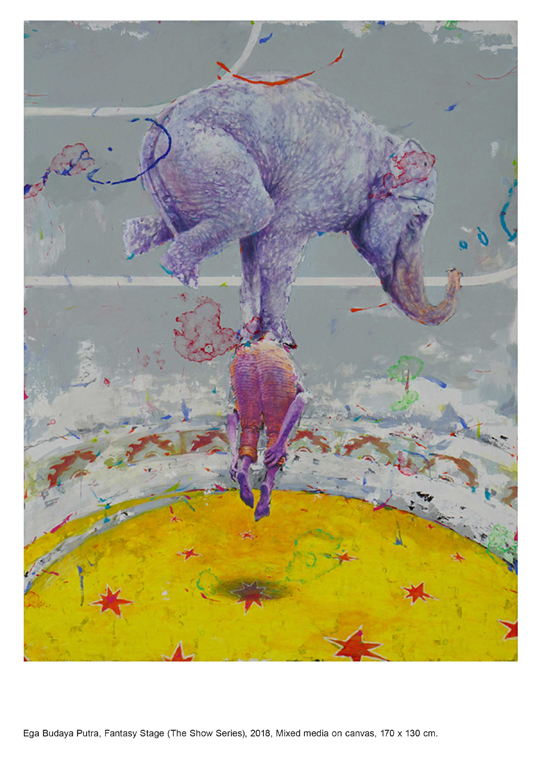
This is also based on the awareness to demonstrate the process of artwork creation by many artists, and without disregarding certain themes, of which usually deeper-dug by the artists. Those themes are incisions between the artists and their society. For instance, themes of indentity, social-politics, cultures, time, space, and many other.
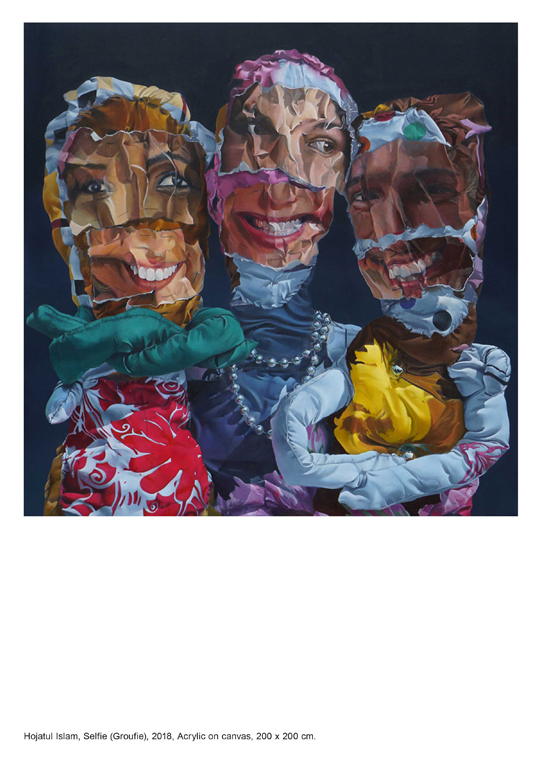
This awareness is built because as time goes by, critical studies and assessments regarding artworks created by artists, the ones that are completely set apart from certain discourse, are even more rarely found. nowadays the critical studies and assessments that are being established are the ones being used as amplifiers for particular stories and issues that are being put together. I believe that this is caused by the careless deal between the artists and reviewers, which is saying that artworks are completely free by its regards of perceptions. This negligence is a failure of understanding what Barthes has conveyed, that creators have died in their works. This is why most art enthusiasts fall and always perceive artworks in its connection with huge agendas of certain exhibitions and discourse. Also, writers who adore these premises will confirm their wide-ranging insights compared to the thought of the artists that they discuss.
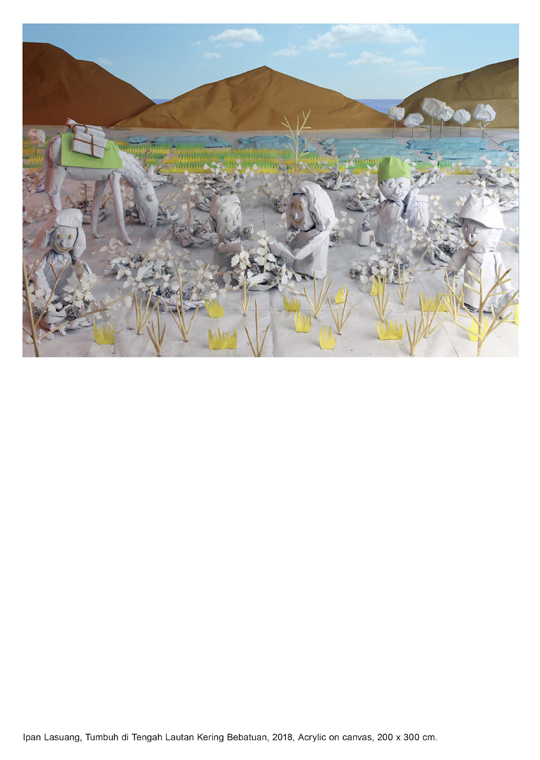
+Plus is an augmentation and combination of elements and materials in constructing more complex structures. These elements can possibly be in forms of working and thinking patterns of artists in their attempt of materializing their works. As for materials, they are the abilities of the artists to conquer the media they are using in their process of creation.
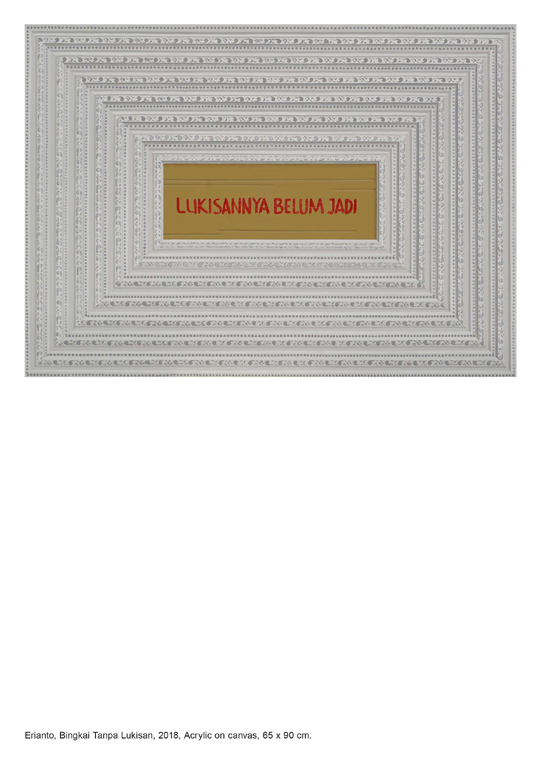
According to the history, this mapping issue of augmentation and combination concepts was born as scientific movements in their purpose of describing the world. Firstly appeared in the 19th century, scientist Jhon Stuart Mill did various experiments, combining chemical and mechanical materials, as a study system of Physics, Biology, and Chemistry. This combining technique is the one practiced by the artists who are participating in the exhibition at the moment. There is also certain belief of freedom in the aforementioned combining technique. The freedom, in the framework of Descarte’s dictum: how an artist or a designer is able to construct an artwork outside of their specific capabilities and expertise. In this exhibition, all the artists truly possess the ability to master everything that they have ‘augmented’ in their work. Therefore, all these works have passed through various kinds of experiments that they had continuously done.
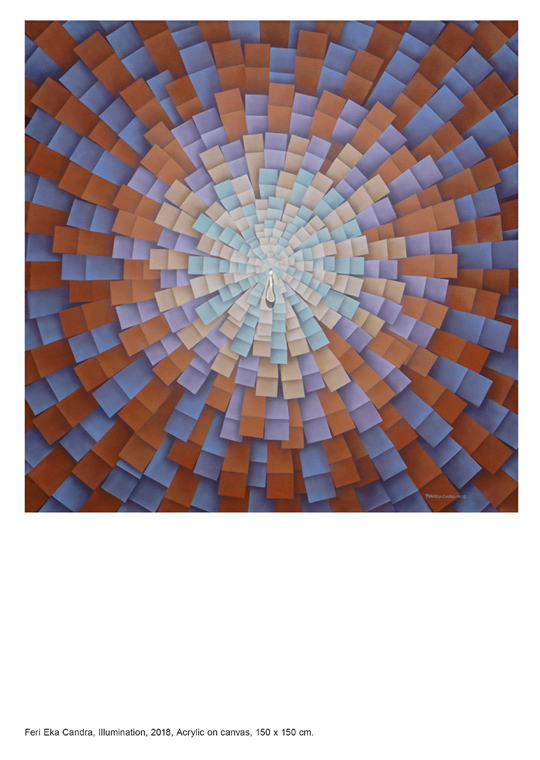
After paying close attention to the method of ‘augmentation’ done by the artists participating in this exhibition, I was able to derive three different patterns of what they have done in their creation process. These three patterns similarly combine two or more of their specific capabilities and expertise. I decided to group these three patterns into: augmenting the less, widening the excessive, and lengthening the shorts.
Augmenting the Less
This patterns works by augmenting several tendencies, forming them into one or two separate artworks. This type of practice can be closely viewed at the works of artists like Agung Santosa, Erianto, Zulfirman Syah, Hojatul Islam, Ipan Lasuang. At first, Agung processed beverage cans into his desired form, of which then followed by processing it into a certain artwork with different materials, in forms of two and three dimensional artwork. The same thing is also done by Erianto. He put layers of frames on his paintings, which then he painted again. He also installed several packages from paper cardboard and plywood, and then painted them too.
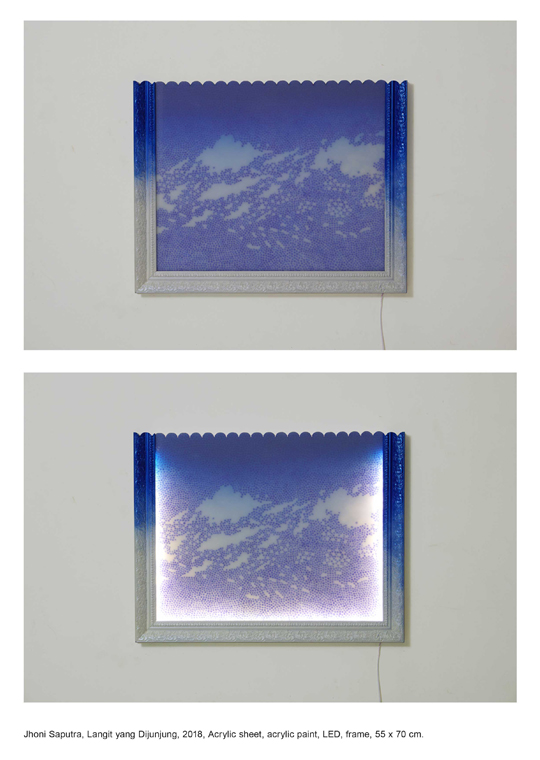
Similarly, Zulfirman focused on the remains of hardened paints that he has compiled and arranged, forming abstracts that he then painted with technique of realist. In the same way, Hojatul and Ipan created a particular model in the first place. They used sewing techniques using cloths, folded and formed with papers. These models can be the whole complete artwork, and also can be separated with the following works that they have painted.
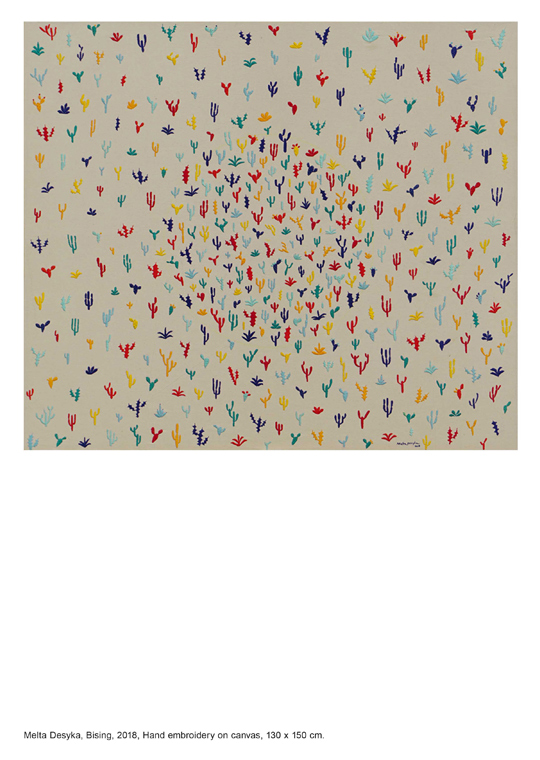
Although Ega Budaya Putra and Feri Eka Candra also use the same pattern, there is a significant difference where they combine two separate tendencies into one complete artwork. They started by painting using objects that they recently like, then they use different media, such as resin. They then combine the painting and the resin into one complete artwork. Some part of the painting is covered by the resin that form a certain object, and there are also paintings that are covered in full.
Widening the Excessive
The pattern of ‘Widening the Excessive’ means that there are several visualization of ways of thinking or inseparable executions in one complete artwork. This pattern is used by Taufik Ermas, Rudi Hendriatno, Jhoni Saputra, and Yusra Martunus. The incisions and cuts in certain parts of Taufik’s paintings result in the arranged work of objects in practice of realist appear to be disproportional. In fact, some of the objects are missing on the painting, replaced by the wall where the painting is placed. The awareness to materialize some kind of order, overridden by ‘destruction’, these are the two patterns that Taufik has combined into one complete artwork.

On the other hand, Rudi had wished to materialize an artwork that is moving, using motionless materials that he combined. He installed a drum from iron plates, both standing and collapsing, depended on the purpose. To show the movements, he made the drum spilled out its solid contents (wood), which were formed similarly to the characteristics of liquid materials (oil).
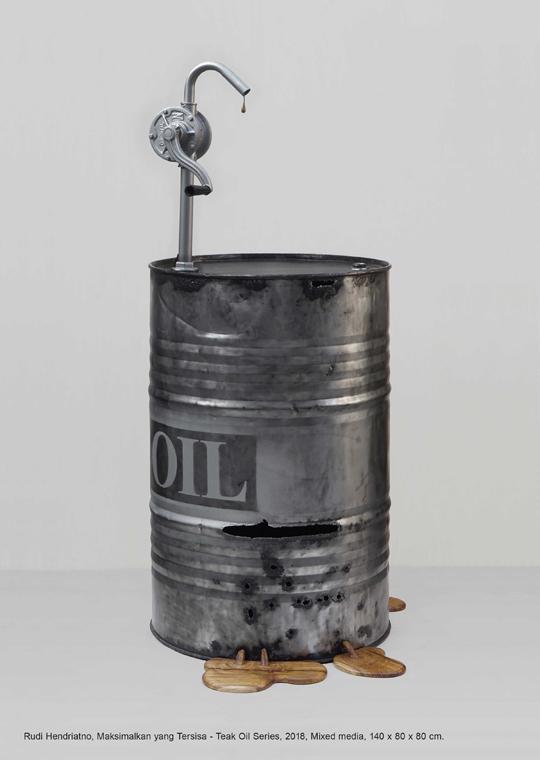
As for Jhoni, he arranged some colorful dots on an acrylic sheet with cut frame, added with several lights that can be turned on and off as he wished. This is a combination of visual and electronics skills, forming one complete artwork.
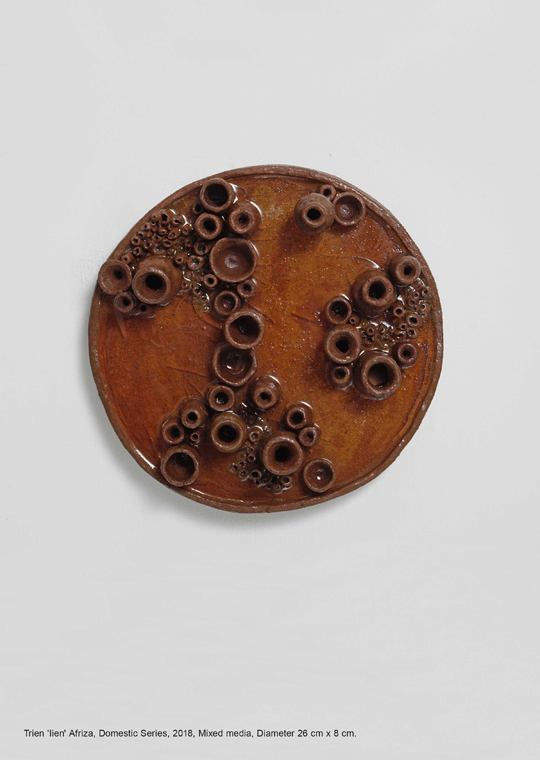
Whereas Yusra showed a more complex pattern, an idea to display burry objects, done with realist technique using spray, augmented with lines that divided the canvas into several measured portions. Just like what we are experiencing when we wait for a picture to show up on Instagram on a bad signal, we see a blurry image with various colors. The object will appear clearly after it is fully downloaded. We can also experience it when we see blurry image captured by camera, as well as the experience of people who are nearsighted when they see colorful lights from afar as a form of color combination because they cannot see them clearly in details. These mistakes are the one realistically done by Yusra. Mistake by its perception from other point of view can be used as reality. The loss of details in the blurry objects makes it impossible to guess what object that is shown, which is free from its true form. The liberty of the blurry is tied with the lines that divide the canvas in measured portions, showing the combination of freedom and order.
Lengthening the Shorts
This pattern follows the habit of the artist in their possibility of other forms and ideas. Dadlan Afrelno, Trien ‘iin’ Afriza, Oktaviyani, Melta Desyka, Dery Pratama. Creating possibilities using acrylics sheets, plainly folded, fragile ceramics that are reshaped to be stronger, and woods that are arranged in ways so they can form words, as well as the ideas of replacing paints used in paintings with thread or wools.
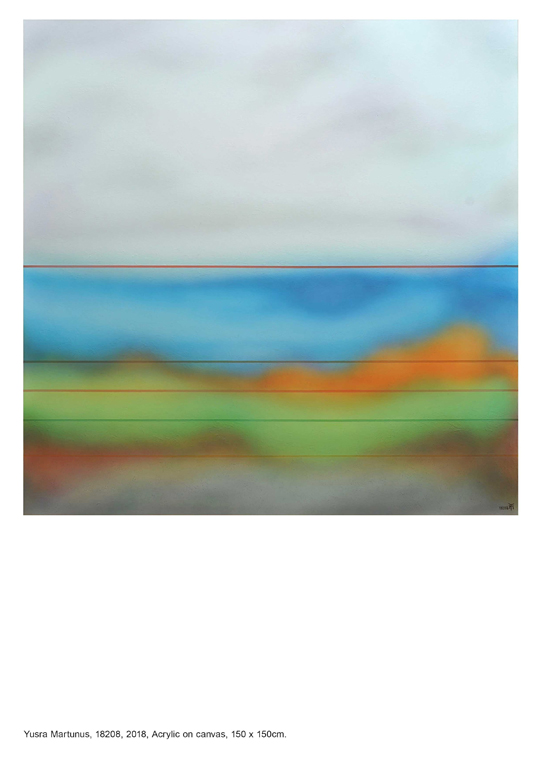
In the end, if we see from overall point of view, involving Sakato Art Community artists in the +Plus exhibition shows the tendency of Descarte’s dictum: how an artist or designer is able to construct a work outside of their specific capabilities and expertise. This is an effort of mapping the tendencies that are done by the artists in this community in their creation process, which are divided into three different patterns: augmenting the less, widening the excessive, and lengthening the shorts. It is also brought into play to raise again the studies of the artists’ consideration: why must it be painted, why must it be formed into three dimensional figures, or what art actually means to the artist, and of course the study of the artworks as well.
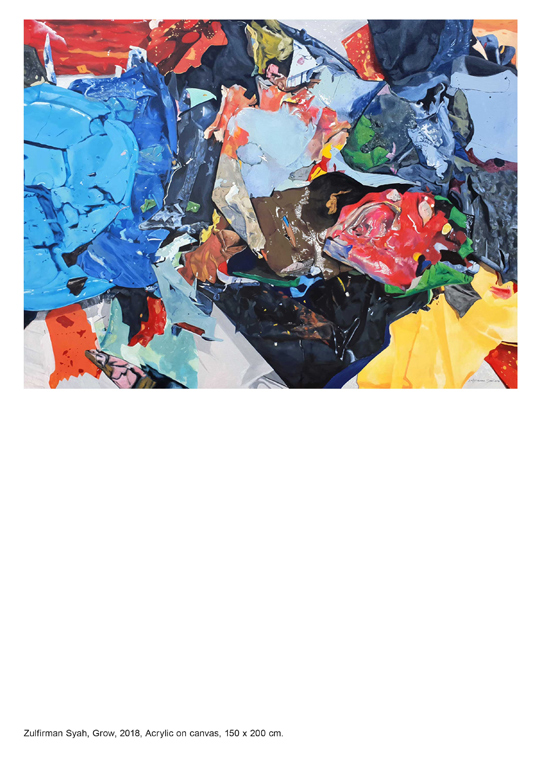
This exhibition also does not have the intention to converse about artworks, in their connections to immense agendas or narrations, as well as other types of discourse. Even though the artists raised some issues in their works, Barthes’ premise in fact, can still be applied on each and every artwork. This premise does not solely ‘kill’ the presence of the artists. If truth be told, it celebrates the freedom of the readers and audience to interpret them from many different perspectives.
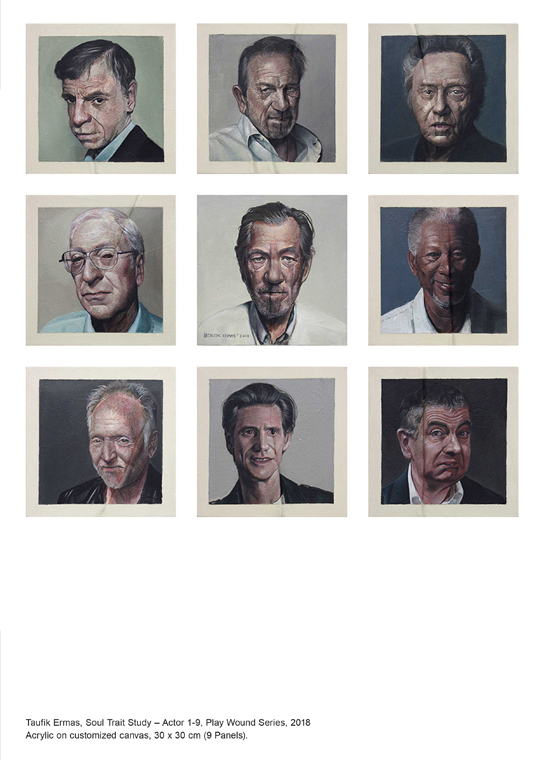
Text and Images courtesy of Nadi Gallery & Anton R Makoginta
Nadi Gallery : 25 October 2018 – 12 November 2018
Suatu kebahagiaan bagi saya dapat kembali bekerjasana menyelenggarakan pameran Sakato Art Community (SAC) dengan tema PLUS.

Perkenalan saya dengan SAC diawali dengan persahabatan dengan teman-teman dari Kelompok Seni Rupa Jendela (KSRJ) —Handiwirman Saputra, Jumaldi Alfi, M. Irfan, Rudi Mantofani, Yunizar— yang merupakan anggota dari SAC juga.

SAC adalah komunitas seni rupa yang beranggotakan seniman yang umumnya berasal dari Minangkabau, Sumatera Barat, sudah lebih dari dua puluh tahun berdiri dan merupakan salah satu komunitas/ kelompok seni rupa yang aktif berkegiatan hingga saat ini. Salah satu contoh bagaimana pendidikan seni rupa dari sebuah daerah, memberi bekal pada sejumlah seniman untuk terus mengembangkan kreativitasnya, tanpa harus lupa pada akar tempatnya tumbuh, kemudian berkenalan dengan berbagai pemikiran, corak, gaya, pendekatan seni rupa kontemporer di Yogyakarta, lengkap dengan lingkup pergaulan sosial yang meluas.

Terimakasih saya ucapkan kepada teman-teman ‘Sakato Art Community’ yang telah mengusulkan pameran ini, kepada para perupa ; Agung Santosa, Dadlan Afrelno, Dery Pratama, Ega Budaya Putra, Erianto, Feri Eka Candra, Hojatul Islam, Ipan Lasuang, Jhoni Saputra, Melta Desyka, Oktaviyani, Rudi Hendriatno, Taufik Ermas, Trien ‘Iien’ Afriza, Yusra Martunus, Zulfirman Syah— dan Erizal As, Faisal Azhari, Bayu Whardana, Anton Rais Makoginta, Handiwirman Saputra. Semoga kerjasama kita dapat terus berlangsung di masa yang akan datang. Terimakasih juga kepada Bapak Rudi Lazuardi yang bersedia membuka pameran ini. Tanpa kerjasama dan bantuan mereka, pameran ini tidak mungkin terlaksana. (Biantoro Santoso)
Curatorial Text by Anton R Makoginta
Pameran ini berdasarkan atas perhatian terhadap kecenderungan sebagian dari seniman Sakato Art Community dalam proses perwujudan karya. Salah satu usaha membicarakan bagaimana proses penciptaan karya, Von Hantelmann dalam esainya The Rise of the Exhibition and Exhibition as Art, dalam Aesthetics and Contemporary Art memunculkan pertanyaan “Apabila karya dalam sebuah pameran— tanpa menimbang tujuan artistiknya—dipakai untuk melayani kebutuhan nilai yang dominan dalam formasi sosial terkini, bagaimana kita bisa membicarakan soal otonomi produksi makna dan pengalaman? Lalu ia menegaskan bahwa seringkali memandang atau memahami karya serta merta dilepaskan dari senimannya ataupun penikmatnya, justeru dikaitkan dengan ruang yang menghadirkannya.

Atas kesadaran memperlihatkan proses penciptaan karya oleh para seniman, bukan bermaksud meniadakan tema-tema tertentu yang sering digali oleh seniman masing-masing. Tema dalam artian sayatan antara seniman dengan lingkungannya, misalnya tema identitas, sosial-politik, kebudayaan, waktu, ruang, dan lain sebagainya.

Kesadaran yang ditimbulkan lantaran semakin jarang kita menemui-baca kajian kritis tentang karya yang diciptakan oleh seniman, belakangan ini beberapa kajian seni tanpa terlepas pada suatu wacana tertentu, atau dengan kata lain karya seni dijadikan sebagai penguat ceritera ataupun isue yang dibangun. Saya merasa hal ini disebabkan pengkaji dan pencipta karya sama-sama sepakat atas keteledoran bahwa karya seni itu bebas-sebebasnya terhadap pembacaan, keteledoran memahami apa yang disampaikan oleh Barthes bahwa pengarang telah mati pada karyanya. Sehingga penikmat seni bisa “terjerembab” untuk selalu mengaitkan karya seni dengan agenda-agenda besar sebuah pameran dan wacana tertentu. Juga penulis pemuja premis tersebut akan memperlihatkan luas wawasannya dari pada pemikiran seniman yang dibahasnya.

+ Plus adalah penambahan atau mengkombinasikan elemen-elemen dan material-material untuk mengkonstruksi sebuah sturuktur yang lebih komplek. Elemen tersebut bisa berwujud pola kerja dan berpikir seniman dalam mewujudkan karya mereka, sementara material merupakan kemampuan seniman menaklukan media-media yang digunakan dalam berkarya.

Berdasarkan sejarah, isu pemetaan dari konsep penambahan (kombinasi) ini lahir sebagai sebuah gerakan ilmu pengetahuan untuk mendeskripsikan dunia. Muncul pada abad 19, Jhon Stuart Mill, seorang ilmuwan melakukan eksperimen- eksperimen penggabungan kimia dan mekanik, sebagai sebuah pembelajaran sistem Fisika, Biologi dan Kimia. Pola penggabungan inilah yang dilakukan oleh seniman-seniman yang berpameran saat ini terdapat suatu kebebasan dalam penggabungan tersebut. Kebebasan itu dalam kerangka Descarte’s dictum: bagaimana seorang seniman atau desainer dapat mengkonstruksi sebuah karya yang diluar kemampuan spesifikasi mereka. Dalam hal pameran ini, para seniman benar menguasai setiap yang mereka ‘tambahkan’ dalam karyanya, sehingga karya-karya telah melalui eksperimen-eksperimen yang dilakukan terus menerus oleh mereka.

Setelah memperhatikan metode ‘penambahan’ yang dilakukan oleh seniman peserta pameran, saya melihat ada tiga pola yang mereka lakukan dalam proses berkarya. Ketiga pola itu sama- sama menggabungkan dua atau lebih spesifikasi kemampuan mereka. Pola tersebut saya kelompokkan kedalam; kurang ditambah; berlebih diperlebar; pendek diperpanjang.
Kurang Ditambah
Pola menambah dari beberapa kecenderungan menjadi satu karya atau dua yang bisa dipisah. Praktik seperti ini bisa dillihat pada seniman Agung Santosa, Erianto, Zulfirman Syah, Hojatul Islam, Ipan Lasuang. Awalnya Agung mengolah kaleng minuman sampai menemukan bentuk yang diinginkan, lantas bentuk itu ditindaklanjuti menjadi karya dengan material berbeda, berwujud dua dan tiga dimensi. Erianto juga melakukan hal yang sama, dia memberikan lapisan-lapisan bingkai pada lukisan yang kemudian dilukis kembali, atau menginstal beberapa package dari kertas kardus dan triplek yang kemudian dia lukis pula.

Senada dengan Zulfirman, dia menggeluti sisa- sisa cat yang bertumpuk telah mengeras disusun sedemikian rupa, tumpukan warna itu berbentuk abstrak, bentuk-bentuk inilah yang kemudian dia lukis dengan teknik realis. Demikian juga dengan Hojatul dan Ipan, mereka membuat model terlebih dahulu, ada yang dijahit dengan menggunakan kain dan dilipat-lipat atau dibentuk menggunakan kertas, model-model itu bisa merupakan suatu karya yang telah jadi atau dapat dipisah dengan karya selanjutnya yang mereka lukis.

Walaupun pola ini dilakukan juga oleh Ega Budaya Putra dan Feri Eka Candra, namun ada perbedaan. Mereka menggabungkan dua kecenderungan yang terpisah menjadi satu karya, awalnya mereka melukis dengan objek-objek yang mereka ganderungi akhir-akhir ini, kemudian menggunakan media lain, seperti resin, lukisan dan objek dari resin ini digabungkan menjadi satu karya. Ada resin menutupi sedikit lukisan berbentuk objek tertentu dan ada yang menutupi seluruhnya.
Berlebih Diperlebar
Pola penambahan pada ‘berlebih diperlebar’ maksudnya dalam satu karya yang utuh terdapat beberapa gambaran cara berpikir atau pengerjaan yang tidak dapat dipisahkan. Taufik Ermas, Rudi Hendriatno, Jhoni Saputra, dan Yusra Martunus melakukan hal ini. Sayatan ataupun potongan pada bagian tertentu di kanvas lukisan Taufik, mengakibatkan keteraturan objek karya dalam praktik realis muncul tidak akan proposional, malahan objek tersebut ada yang sampai hilang pada lukisan dan diganti dengan dinding tempat lukisan dipajang. Kesadaran mewujudkan suatu keteraturan yang ditimpa dengan ‘pengrusakan’, dua pola ini yang digabung oleh Taufik dalam satu karya.

Keinginan Rudi mewujudkan karya yang bergerak menggunakan material yang diam digabung menjadi satu. Ia menginstal drum dari plat besi yang berdiri ataupun tidur tergantung, untuk memperlihatkan ada pergerakan ia membuat isi dari drum tersebut keluar tumpah, namun yang keluar dari drum tersebut benda padat (kayu) yang dibentuk menyerupai karakter benda cair (minyak).

Jhoni menata titik-titik dengan beraneka warna pada akrilik sheet yang dibingkai terpotong, ditambah dengan menggunakan beberapa lampu yang bisa nyala-mati sesuai dengan keinginannya. Kemampuan visual dan elektronika digabung dalam satu karya.

Pola yang lebih kompleks terlihat pada karya Yusra, gagasan menampilkan objek yang samar (blur) dikerjakan dengan teknik realis menggunakan spray ditambah dengan beberapa garis yang membagi bidang kanvas yang terukur. Barangkali kita pernah mengalami saat menuggu gambar di Instagram muncul disaat signal tidak begitu bagus, kita akan melihat gambar itu blur dengan aneka warna, objek itu akan jelas jika telah terdownload seluruhnya. Atau pernah melihat foto-foto tangkapan kamera yang blur. Juga bagi orang rabun jauh atau mata minus akan melihat lampu warna-warni dari kejauhan sebagai bentuk gabungan dari beberapa warna karena tidak mampu melihat dengan detail. Kekeliruan tersebut yang dikerjakan dengan realis oleh Yusra, artinya kekeliruan atau kesalahan di lain hal bisa menjadi sebuah kebenaran di pihak lain. Kehilangan detail pada objek blur itu sesungguhnya tidak bisa diterka objek apa sebenarnya, objek itu bebas dari bentuk aslinya. Kebebasan pada blur diikat dengan garis-garis yang terukur membagi kanvas, terlihat bahwa adanya padu padan antara yang bebas dengan yang teratur.
Pendek Diperpanjang
Pola ini melanjutkan kebiasaan seniman pada kemungkinan bentuk-bentuk atau gagasan lain. Dadlan Afrelno, Trien ‘iin’ Afriza, Oktaviyani, Melta Desyka, Dery Pratama. Kemungkinan-kemungkinan yang bisa diciptakan menggunakan akrilik yang lemabran datar ditekuk, keramik yang rapuh diusahakan menjadi kuat, dan kayu yang disusun-susun sehingga membentuk kata-kata. Serta kesadaran melukis dengan cat diganti dengan menggunakan benang jahit atau sulam.

Terakhir, secara keseluruhan memang, melibatkan seniman-seniman Sakato Art Community dalam pameran + (plus) memperlihatkan kecenderungan Descarte’s Dictum: bagaimana seorang seniman atau desainer dapat mengkonstruksi sebuah karya yang diluar kemampuan spesifikasi mereka. Sebagai usaha pemetaan kecenderungan yang dilakukan oleh seniman dalam komunitas ini dalam proses berkarya mereka, yang terbagi pada pola: kurang ditambah; berlebih diperlebar; pendek diperpanjang. Guna untuk memunculkan kembali kajian-kajian tentang pertimbangan seniman kenapa harus dilukis, dijadikan objek tiga dimensi atau kesenian itu apa bagi senimannya, tentunya kajian tentang karya itu sendiri.

Usaha kali ini juga bukan hendak memberbincangkan karya seni yang berkaitan dengan agenda- agenda ataupun narasi besar, juga wacana lainnya. Walaupun seniman memunculkan pada setiap karya mereka, toh premis Barthes masih bisa diterapkan pada setiap karya. Premis yang bukan semata-mata ‘membunuh’ kehadiran seniman, malahan merayakan kebebasan pembaca untuk menginterprestasi dalam berbagai macam perspektif.

 308
26/11/2025
308
26/11/2025
REFLECTIONS OF DESIGN — MAGIS AT MILANO DESIGN WEEK 2025
Magis reflects the evolving spirit of contemporary design at Milano Design Week 2025, where imagination finds its most poetic form.
read more 400
26/11/2025
400
26/11/2025
SABA’S LIMES BY SERGIO BICEGO RETURNS WITH A REFINED EXPRESSION
Saba’s Limes by Sergio Bicego returns in 2025 with a refined expression.
read more 12.77K
20/11/2025
12.77K
20/11/2025
JAIPUR RUGS X PETER D’ASCOLI PRESENTS THE GILDED AGE COLLECTION (2025)
The Gilded Age collection by Jaipur Rugs X Peter D’Ascoli channels the decadent glamour of 19th-century design into bold, hand-knotted rugs that exude...
read more 10.33K
19/11/2025
10.33K
19/11/2025
BITOSSI HOME’S FALL/WINTER 25/26: A SEASON OF PLAYFUL ELEGANCE AT THE TABLE
Discover the new elegance of Bitossi Home’s Fall/Winter 2025–26 Collection at Maison & Objet, Paris this September.
read more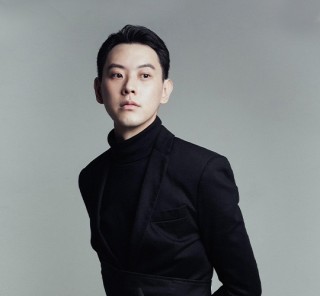 80.49K
10/01/2025
80.49K
10/01/2025
W RESIDENCE IN SOUTH JAKARTA BY MICHAEL CHANDRA
Michael Chandra, founder of MNCO Studio Design has created the W Residence with an aesthetically pleasing, practical, and pleasant home from all...
read more 44.33K
11/07/2025
44.33K
11/07/2025
PELUNCURAN PERDANA LEGANO HOME MENGGANDENG AGAM RIADI DI ST REGIS RESIDENCE JAKARTA
Peluncuran perdana LEGANO HOME menggandeng Agam Riadi di St. Regis Residence Jakarta: menyatukan kemewahan dan jiwa dalam sebuah ruang.
read more



